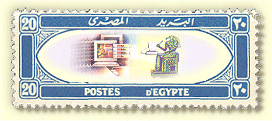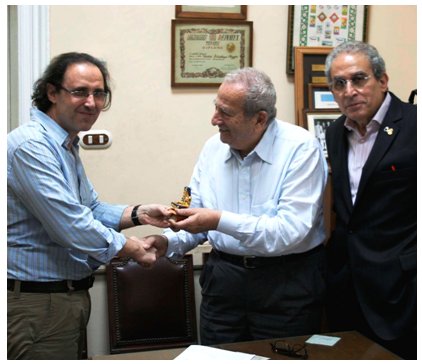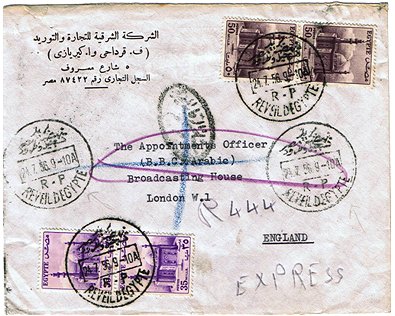

| Report of the Meeting, May 7 2011 |
||
|
PRESENT: Sixteen members were present; apologies for absence were received from six members.
The Chairman welcomed those present, and especially Peter Goodwin, who he was delighted to see as a representative from so far away, and looked forward to the possibility of the renewal of the Circle's visits to hospitable New Zealand. He was happy to be able to report the success of two of our members at the Philatelic Show 2011, held in Boston, which qualifies them to enter the American Philatelic Society's World Series of Philately: Dick Wilson, (ESC 230), our North American Agent, took gold with his single frame (16 sheets) exhibit of The 3 millièmes Army Post Stamps used by the British Forces 1936-1941; and Trent Ruebush (ESC 197) won a gold medal for his eight-frame collection of Egypt's Fourth Issue, 1879-1913, narrowly missing out on the Grand Award. There were further congratulations for Mike Murphy and Ibrahim Shoukry, whose Rural Post book stepped up at the New Zealand Philatelic Literature competition in March, gaining two further points and a gold medal, as well as a much appreciated critique from the judges.  The Secretary's remarks, brief for a change, included the news that the Macarthur Award, now suitably engraved, had been sent back to Cairo with Dr Sherif Samra, President of the Philatelic Society of Egypt. And now we can report that it was successfully presented to Hany Salam (ESC 580) by our Egypt Agent., Dr Ibrahim Shoukry, at a convivial gathering in our colleague society's clubrooms in downtown Cairo.
The Secretary's remarks, brief for a change, included the news that the Macarthur Award, now suitably engraved, had been sent back to Cairo with Dr Sherif Samra, President of the Philatelic Society of Egypt. And now we can report that it was successfully presented to Hany Salam (ESC 580) by our Egypt Agent., Dr Ibrahim Shoukry, at a convivial gathering in our colleague society's clubrooms in downtown Cairo.
Hany Salam, left, receives the trophy from Ibrahim Shoukry as Sherif Samra looks on. The Secretary informed members that the next meeting would be John Davis on Hotels at the Victory Services Club on July 9 - something to look forward to - but then we will be in research mode at Stampex on September 17, aiming to update Peter Smith's masterly work on the listing of TPO lines and dates. We are delighted that this website has recently been embellished with the full listing from the 1983 book for all members to consult. We hope that as many as possible will be able to consult the list, measure their own holdings against it, and proclaim any new routes or early or late dates … after 28 years there must be hundreds of pieces of information to add, if not thousands. Please, please record your offerings according to Peter's type classification numbers, as we intend to start at the beginning at Type 1 and work through as far as possible to Type 8B1. It should be a fascinating meeting, and result in many new discoveries. The Treasurer then reported that though there were a few members to be lapsed for non-payment of subscription, forgetfulness could quickly be conquered if members took a moment to prepare a standing order from their bank, payable in the first days of each year: easy for the member, easy for the Treasurer! Our President, wearing his Auctioneer's hat, announced that the present team would be happy to run another major auction in the autumn as the Circle's No 50 - but again appealed to any member willing to pick up the baton and take up the challenge of carrying on what has become an economically necessary part of the Circle's functioning. If there are no volunteers, there is a strong possibility that the Auction will die - and the Circle will very much suffer thereby. For the autumn, encouraged by the proportion of sales at the Live auction when all lots were illustrated, we hope to be able to do the same again for the much larger number of lots - though we must point out that it will not be possible, either economically or physically, to illustrate all lots in a printed form. All illustrations we receive will be shown on this site, and we encourage those without the facility to visit their local library or next-door neighbour to see the wonderful array. We encourage all members submitting lists to add as many illustrations as possible: pictures definitely sell! Lists of lots should be with the Secretary by August 1, and the closing date for bids will be September 15. And so it was on to the meeting, with Mike Murphy on "Named" Post Offices - a query for some members, but easily explained: in 1984 he listed in the QC a large number of "second echelon" postmarks related to the Hotels study, comprising Palaces, Universities, Dams/Barrages and the like, and extending to other out-of-the-way markings such as Savings Banks, Parliament and so on. Anything except "normal" town offices… Mike apologised: he knew when he volunteered to give the talk that he had accumulated more material since that 1984 listing… but when he came to mount it for display it just kept coming! In the end there were over 240 pages, so what to leave out? Happily the preliminary part of the meeting had been short, so there was (perhaps) time enough to show them all… In the end, even at breakneck speed, some sections had to be left out. But the meeting saw a wide range of material from the late nineteenth century to the early twenty-first, all of it related to the categories mentioned above, and some of it quite unusual … under Dams/Barrages, for instance, he was able to show the difference between the name qanatir (barrages, plural) and khazzan (dam, singular), to explain Qanatir el Delta and Qanatir el Khairia, the same place but different post offices, and to show covers bearing both markings simultaneously, to show multiple different markings from Aswan, Asyut and the Delta barrages/dams, and very rare covers from Nag Hamadia, Dahtoura/Zifta and Isna.
Cairo University, originally known as Fouad I University, apparently used its earliest handstamp only for First-Day covers, while Alexandria University, an offshoot from Fouad, apparently had no CDS at all. But the more modern universities were all well represented, including Aswan University, one of three branches of the Nile Valley University, showing a remarkable postmark incorporating its postcode. Educational establishments up and down the country have grown rapidly in the last forty or so years, and each seems to have proudly borne its own postmark. Another branch of the study to grow rapidly was that of the Presidency, with postmarks representing several branches, including one that seems to win with ease the contest for longest wording: PRESIDENCY OF / THE REPUBLIC / PRESIDENT'S OFFICE FOR PUBLIC RELATIONS. The first Republican postmark, PALAIS / DE LA / REPUBLIQUE, makes its message clear, but it is immediately followed by COMITE DIRECTEUR / DE LA / REVOLUTION, and obviously there is more to be learned here. Parliament developed through Nasser's National Assembly (1962-1977) to the two houses of the Majlis el Shaab (People's Assembly) and the Majlis Shura (Consultative Council) until February this year, when it all stopped suddenly. We wait to see what happens next. Equally, Government ministries proliferated from joint post offices serving several ministries to individual postmarks for each branch, including some very odd spellings indeed: POSTE / MINISTERE DU FINAUCH (finance), MINISTERE DE L'EDUCA / TION ET DE L'ENSE / IGNEMENT, and MINISTRY OF / GUSTIC / P.OFFICE (justice) being among the oddest. Commercial and industrial offices also found their place, including ATOMIC ENERGY POST, BAHARIA IRON ORE MINES, the ALUMINIUM SMELTER COMPLEX as well as BAZAR DES LEGUMES ET DE FRUITS, with variants from Alexandria, Port-Said and Zagazig. And there were examples of markings from the CAIRO TOWER and the EGYPTIAN MUSEUM.  One of Mike's favourites was the post office REVEIL D'EGYPTE, named for Mahmoud Moukhtar's famous granite statue of the awakening Sphinx which was moved from where it was sculpted, outside the main Cairo railway station, to the University in the mid-1950s. At about the same time the post office markings (right)? begin to be recorded. But where was/is the post office. The only clues in the return addresses of letters posted there seem to indicate somewhere on 26 July Street.
One of Mike's favourites was the post office REVEIL D'EGYPTE, named for Mahmoud Moukhtar's famous granite statue of the awakening Sphinx which was moved from where it was sculpted, outside the main Cairo railway station, to the University in the mid-1950s. At about the same time the post office markings (right)? begin to be recorded. But where was/is the post office. The only clues in the return addresses of letters posted there seem to indicate somewhere on 26 July Street.
The variety of material shown was enormous - perhaps too much to take in. It is hoped to publish a full illustrated list of postmarks and dates, but the evidence that there are lots more examples to find seems overwhelming. The Chairman thanked Mike for presenting an entertaining afternoon and showing what could be made from "a collection of bric-a-brac" - and, more importantly, indicating that there is plenty of potential for research into the postal history of the post-Monarchy period. Members showed their appreciation in the traditional manner. |
|
|